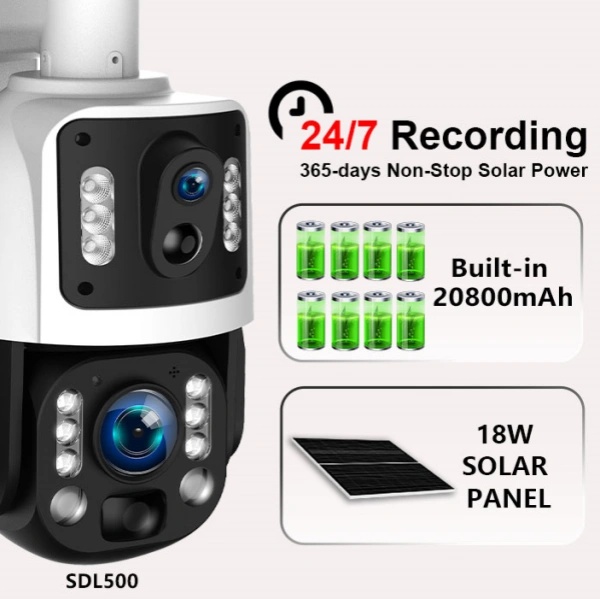Remote Firmware Upgrades: The Key to Continuously Optimizing Solar Security Camera Systems
Imagine this scenario: you’ve successfully deployed a fleet of 50 solar-powered 4G security cameras across a vast construction site or remote farm. The system works perfectly. But six months later, a new security vulnerability is discovered, or the local 4G carrier updates its network protocols, causing intermittent connectivity. The prospect of sending a technician to manually update each camera—climbing poles, accessing difficult locations, and spending days on-site—is a logistical and financial nightmare. This is a critical pain point for any security project manager, installer, or distributor.
This is where Firmware Over-The-Air (FOTA), or remote firmware upgrades, transforms from a convenient feature into an essential operational backbone. As an engineer who has spent over a decade designing these systems, I can state unequivocally that a robust FOTA strategy is as crucial as the camera’s sensor or solar panel. It’s the key to long-term reliability, security, and profitability for your projects.
What is FOTA and Why is it Non-Negotiable for Solar Security Cameras?
Firmware Over-The-Air (FOTA) is the process of remotely updating the software embedded within a device’s hardware without any physical intervention. For a desktop PC, this is a simple process. For a wireless outdoor security camera powered by the sun and connected via a 4G network, the stakes are exponentially higher.
The challenges are unique:
- Power Constraints: A solar camera operates on a tight power budget. A poorly designed update process can drain the battery, especially on a cloudy day, potentially taking the camera offline for an extended period. A reliable FOTA system must be incredibly power-efficient.
- Unstable Connectivity: Unlike stable office WiFi, 4G signals in remote areas can fluctuate. An update must be resilient enough to handle dropped connections without “bricking” the device—rendering it permanently inoperable.
- Physical Inaccessibility: The entire purpose of a solar 4G camera is to provide security in locations without power or wired internet. By definition, these sites are often hard to reach. FOTA eliminates the single highest operational cost associated with these deployments: physical maintenance visits.
Without FOTA, a deployed fleet of cameras is frozen in time. They cannot adapt to new threats, benefit from performance improvements, or resolve compatibility issues. They become a depreciating asset with a ticking clock on their obsolescence.
The Hidden Costs: Manual vs. Remote FOTA Upgrades
For B2B clients like distributors, installers, and large-scale project managers, the total cost of ownership (TCO) is paramount. A camera’s sticker price is only one part of the equation. Maintenance and operational overhead can quickly eclipse the initial hardware cost. This table breaks down the stark reality of relying on manual updates versus embracing a FOTA-enabled system.
| Feature | Manual Firmware Updates | Remote FOTA Updates (UBOXCAM) |
|---|---|---|
| Cost & Labor | Extremely high. Requires technician travel, on-site time, and specialized equipment. | Near zero. Updates are pushed from a central dashboard with a few clicks. |
| Time & Efficiency | Days or weeks to update a large fleet. High potential for project disruption. | Minutes. An entire fleet can be updated simultaneously during off-peak hours. |
| Scalability | Poor. The cost and complexity grow linearly with every camera added. | Excellent. Managing 1,000 cameras is as simple as managing 10. |
| Security Patching | Slow reaction time leaves systems vulnerable for extended periods. | Immediate deployment of security patches, neutralizing threats as they emerge. |
| Risk of Error | High. Human error during manual flashing can easily “brick” a device. | Low. Automated pre-update checks and rollback mechanisms prevent failure. |
An Engineer’s Perspective: The UBOXCAM FOTA Advantage
Not all FOTA systems are created equal. A basic implementation can be risky. At UBOXCAM, we’ve spent years refining our FOTA process, building it from the ground up to address the specific challenges of solar security cameras. This isn’t just a feature; it’s a core part of our product philosophy.
Here’s what happens under the hood:
- Intelligent Pre-Update Checks: Before any update begins, our system automatically verifies the camera’s status. Is the battery level above 50%? Is the 4G signal strong and stable? This simple check prevents 99% of potential update failures. This process works hand-in-hand with our advanced Battery Management System (BMS) to ensure total system stability.
- Differential Updates: We don’t transmit the entire firmware file (often 50-100MB) for a minor fix. Our system intelligently identifies only the changed code blocks and sends a small, lightweight patch. This conserves 4G data—a critical cost factor for large deployments—and minimizes battery consumption.
- Robust Rollback Mechanism: In the rare event an update is interrupted (e.g., sudden power loss, complete signal drop), the camera isn’t left in a corrupted state. It automatically reverts to its last known stable firmware version and reports the failure. The camera remains operational, and the update can be re-initiated later.
- Secure & Authenticated: Every firmware file is digitally signed. The camera authenticates this signature before accepting the update, preventing malicious actors from pushing compromised firmware to your devices.
This multi-layered approach ensures that updating your camera fleet is not a source of anxiety, but a routine, reliable process. This is the difference between a consumer-grade gadget and a professional-grade security tool. [SVG_FOTA_Process_Diagram]
Case Study: Securing a Large-Scale Agricultural Operation
- Problem: A large farming cooperative in the US Midwest deployed 80 of our 4G solar cameras to monitor irrigation equipment and prevent theft across thousands of acres. A year into deployment, they wanted to add a new AI-powered person detection feature to reduce false alerts from animals, a capability that wasn’t available at the time of purchase.
- Solution: A manual update would have been a logistical impossibility, requiring weeks of work and thousands of dollars in labor and travel. With the UBOXCAM management platform, the client’s IT manager scheduled a bulk FOTA update for the entire fleet. The update was pushed during a low-activity period overnight.
- Result: All 80 cameras successfully received the new firmware, gaining advanced AI capabilities without any physical intervention. The client reported an 85% reduction in false alerts, allowing their security team to focus on real events. The return on investment (ROI) was immediate, saving countless hours of reviewing irrelevant footage and enhancing the overall security posture. This future-proofed their initial hardware investment.
Your FOTA Questions, Answered
As a partner to our B2B clients, we believe in transparency. Here are answers to the most common questions we receive about our FOTA process.
- How much data does a typical firmware update consume?
Thanks to our differential update system, a typical bug fix or performance patch is only a few megabytes (MB). Major feature upgrades might be larger but are still heavily optimized to minimize data usage on your 4G plan. - Can I control when the updates happen?
Absolutely. Our centralized management platform gives you full control. You can push updates immediately, or better yet, schedule them for specific cameras or groups during off-peak hours (e.g., 2 AM) to ensure zero operational disruption. - What if a camera is offline during a scheduled update?
The platform will register the failed attempt. As soon as the camera comes back online, it will check in with the server and automatically initiate the pending update process, ensuring your entire fleet stays synchronized.
Checklist: Choosing a Supplier with a Future-Proof FOTA Strategy
When evaluating a solar security camera manufacturer for your business, don’t let FOTA be an afterthought. Use this checklist to ask the right questions:
- ✅ Do they offer a true FOTA capability for their entire product line?
- ✅ Can they explain their process for ensuring update stability (e.g., pre-checks, rollbacks)?
- ✅ Do they use efficient methods like differential updates to save on data costs?
- ✅ Is the update process secured against tampering and unauthorized access?
- ✅ Does their management platform allow for easy, scalable fleet management and scheduling?
Choosing a partner who can confidently answer “yes” to these questions is choosing a partner for long-term success. At UBOXCAM, our engineering is built around providing you with a reliable, secure, and continuously improving security ecosystem. If you are a brand, wholesaler, or project installer, partnering with a factory that has this capability is your ultimate competitive advantage. Contact our team today to learn how our advanced FOTA-enabled solar cameras can reduce your operational costs and delight your customers.

